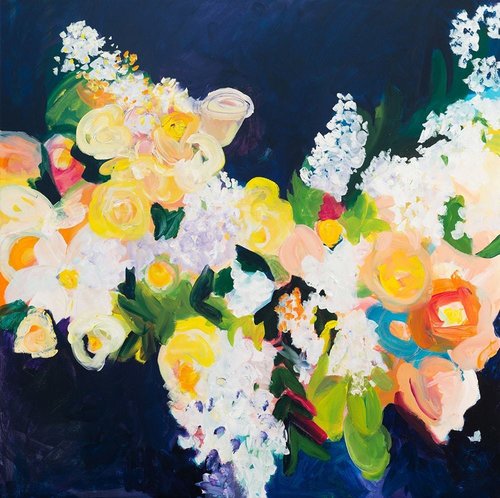by Carolyn Edlund
In our fast-paced world, what’s brand new gets the most attention. Is your portfolio ready with your latest work?

Fresh from the easel: Ruth-Anne Siegel presents a new painting titled “Midnight”, acrylic, 36″ x 36″
Back in the day when I ran my own production studio, I sold my work wholesale to galleries, shops and stores all over the country. I knew at the time that the first question I would get when speaking with one of my regular customers would be, “What’s new?”
That question is one that all artists should be ready to answer. It is often the key to making sales, and repeat sales.
Gallery managers and wholesale buyers are always looking for fresh product to present to their own regular customers. Those customers stop in over time, eagerly looking forward to new merchandise. As a rule of thumb, artists who wholesale should plan to produce 30% new designs each year. This keeps their collections vibrant and selling. Without new work, sales tend to decline. Store buyers will not place those important repeat orders if they can’t purchase new product.
It’s a natural tendency that people want to see the newest, and the latest – well, everything. The fashion world presents a never-ending parade of clothing and accessories each season, meant to influence trends and drive sales. Designers bank on customers flocking to stores to shop and buy the most current looks. When a store employee opens a stock box out on the sales floor, it can draw shoppers who want to get the first look and best selection of merchandise, right out of the box.
Although art and “home décor” trends move more slowly than fashion trends, there is always something new and interesting to see. And fortunately, it’s all for sale. Catching that wave can help you sell your own artwork, too. This is one reason why artists who are showing and promoting work in progress often sell paintings as soon as they’re dry. It’s why email opt-in forms often promise subscribers a preview of the newest work as an incentive to sign up.
When you don’t have the newest and latest work to share, it can affect sales negatively. Some artist websites show collections categorized by year. If the current year doesn’t have new artwork (or much of it), the site tends to look stagnant, whether that is a fair assessment or not. It may be that the artist needs to have photos taken, or upload images of their latest collection. If that’s the case with you, then making sure your art website is current should be the next task on your To-Do list.
Artwork itself is not the only updating that should be done on a website. Footers that show copyright dates from previous years are signs that an artist might be out of business. Likewise, art blogs with the last entry posted long ago don’t inspire confidence in your visitors, and “events” pages with out of date calendars give a poor impression. If you’re still actively making and selling your art, you must keep all content including visual and written materials up to date.
You may also want to reconsider if your practice is to place a date on your artwork. If unsold, it may eventually be seen as old, leftover and possibly undesirable simply because it’s not new.
You must also have a large enough selection for shoppers to choose from in order to keep sales brisk. Retail store owners know that sales will slow dramatically when displays sell down, and that the last couple of items on a display virtually never sell. Likewise, the body of work you offer for sale must be large enough to give potential collectors the feeling that they have a wide enough choice of art to choose from. And that robust selection will, of course, feature your newest work.
Artist credit: Ruth-Anne Siegel. See her website here.



Hello I am a young artist of 23 years of age i have a lot of art to sell however I don’t have a website. Can you please suggest a good website I can sell my drawings and paintings?
Hi Maisie, Thanks for your question. There are plenty of places to create a website easily, because they use a “template” system. Sites like Crevado, ArtSpan or Shopify are examples. See my directory of places to sell for more options here https://www.artsyshark.com/125-places-to-sell/ Upload your photos per their instructions, describe your work, add content on your “About” page, etc. and you will have a beginning website that will give you a presence online. If you don’t have a lot of portfolio images, you may find a free level at some of these template website providers, so you don’t have to spend anything to get started.
Very helpful. Thanks for the direction.
What’s the magic number of art pieces to have on hand at a given time?
If an artist posts artwork on their website, would a gallery consider what is shown as possibilities for their display or would the art be viewed as something of the past? I’m just trying to gauge the amount of artwork & time involved to become successful in this business.
Lisa, there is no “magic” number of works to present, but you need a critical mass. I like to see at least a dozen works or more when I view a website – that would be enough to get a sense of what the artist has done. And, it would be representative of the artist’s current direction. Your portfolio should look forward, not back – don’t pad with things you no longer do to make it bigger. Your portfolio will be judged on the least successful piece you show, so keep your selection of the highest quality.
Thanks for your help & quick reply.